Code reference information
This section describes how to see definitions of symbols, display documentation references, and use the view parameter information feature.
Definitions
In PyCharm, you can see where and how symbols, such as tags, classes, fields, methods, or functions are defined in your project. For this purpose, the IDE features the Quick Definition popup.
To view definition of a symbol, select it in the editor and press Ctrl+Shift+I (or click View | Quick Definition).
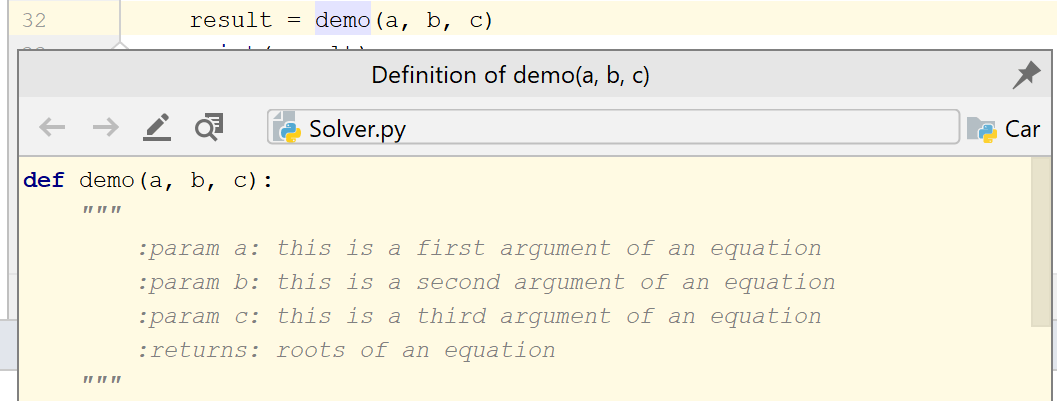
Alternatively, with the Ctrl key pressed, hover the cursor over any symbol. PyCharm displays the symbol as a link and shows its definition in a tooltip. Click this link to jump to the definition of the symbol.
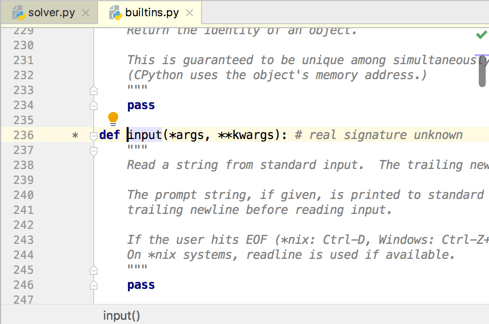
You can open a definition in the Find tool window. To do so, click the icon in the top-right corner of the popup and click
Open in Find Tool Window.
To open the source code of the definition for editing and close the popup, click the icon and then click
Edit Source(F4).
tip
Type definitions
The Quick Type Definition feature allows you to view the type definition of variables, fields, methods, or any other symbols in a popup without switching from the code you're editing.
Place the caret at the symbol for which you want to view the type definition and select View | Quick Type Definition.
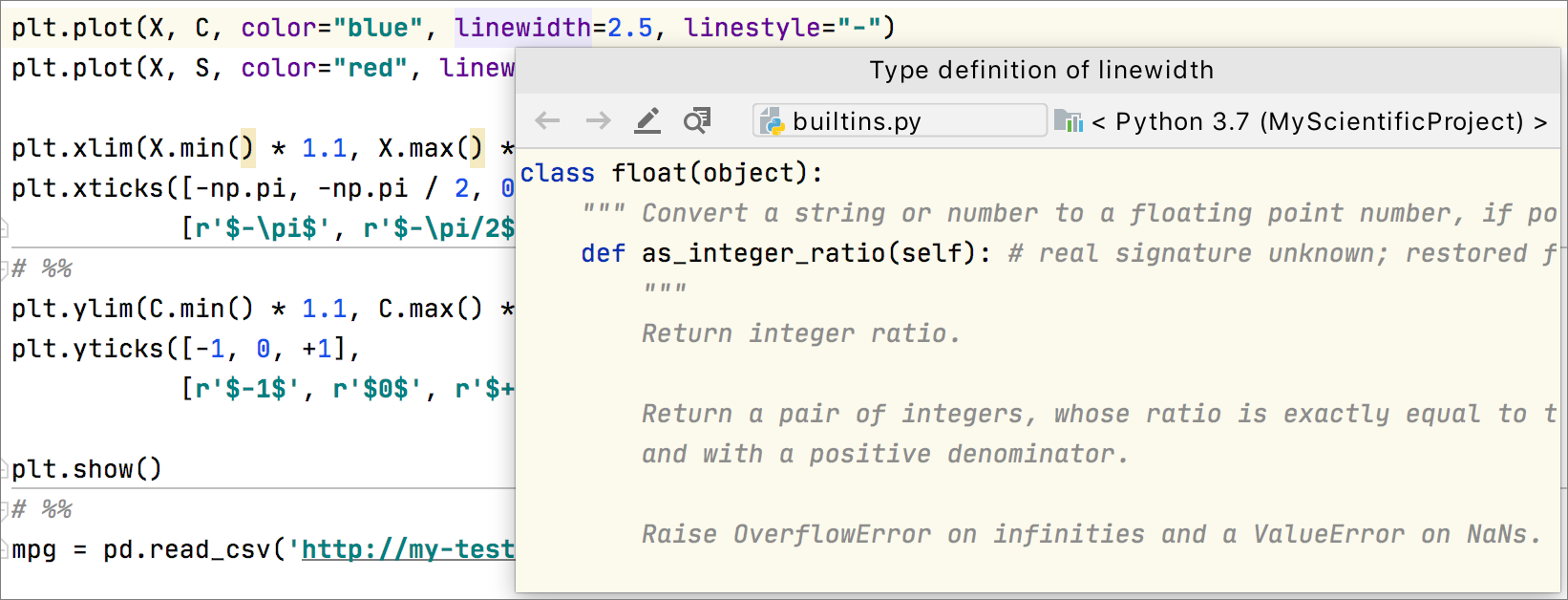
To open the source code of the definition for editing and close the popup, click the
icon and then click
Edit Source(F4).
PyCharm doesn't have a default keyboard shortcut for this action, but you can manually configure it in the settings. For more information on how to configure custom shortcuts, refer to Configure keyboard shortcuts.
Parameter info
The Parameter Info popup shows the names of parameters in method and function calls. PyCharm automatically shows a popup with all available method signatures within 1 second (1000 milliseconds) after you type an opening bracket in the editor, or select a method from the suggestions list.
You can explicitly invoke the popup if it has closed or if your IDE is configured not to show the popup automatically. To do so, press Ctrl+P (or click View | Parameter Info).
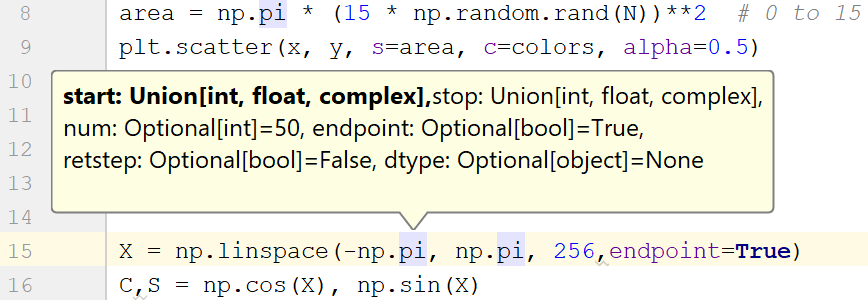
Show full method or function signatures
By default, the parameter info popup shows simple signatures. You can configure the IDE to show full signatures that include method names and returned types.
In the Settings/Preferences dialog Ctrl+Alt+S, go to Editor | General | Code Completion, and select the Show full method signatures checkbox.
Make sure to include the required third-party JavaScript libraries in the project source path. Otherwise, the names of parameters will not be displayed.
Configure the parameter info popup
In the Settings/Preferences dialog Ctrl+Alt+S, go to Editor | General | Code Completion.
In the Show the parameter info popup in ... milliseconds field, specify the time in milliseconds after which the popup should appear.
If you don't want the popup to appear automatically, clear the Show the parameter info popup in ... milliseconds checkbox.
Inlay hints
Inlay hints are special markers that appear in the editor and provide you with additional information about your code, like the names of the parameters that a called method expects. Other types of hints inform you about annotations, method parameters, usages, and so on (depending on the language).
Some of the hints are enabled by default.
You can fine-tune inlay hints in Settings/Preferences | Editor | Inlay Hints. For detailed explanation of what each type does, see Inlay Hints.
Configure the parameter hints exception list
If you don't want to see parameter hints for specific methods, you can configure the list with exceptions. By default, the exception list contains a number of pre-defined methods. You can remove a method from the list to see the hints for it, or add new methods to hide their hints in the editor.
In the Settings/Preferences dialog Ctrl+Alt+S, select Editor | Inlay Hints and click the necessary language.
Select Parameter hints in the list in the middle section.
The options for configuring hints become available on the right.
Add methods for which you don't want to see the hints to the Exclude list section.
Add cases for which you do not want to see the hints to the Exclude list section. To add a case, click the inline hint in your code, press Alt+Enter and select Do not show hints for current method.
Apply the changes and close the dialog.
Quick documentation
You can get quick information for any symbol or method signature by means of the Quick Documentation popup.
PyCharm recognizes inline documentation created in accordance with PEP-257.
View quick documentation
Hover the mouse over the necessary symbol to view its documentation, or place the caret at the symbol, and press Ctrl+Q(View | Quick Documentation).
Press Ctrl+Q again to switch between the popup and the toolbar.

Click links in the documentation topic to preview documentation for a top-level elements (in this example: math) or to the related types (in this example: float).
Click in the popup to change the font size, display the quick documentation toolbar, or go to the source code.
Disable quick documentation on hover
In the Settings/Preferences dialog Ctrl+Alt+S, go to Editor | Code Editing | Quick Documentation and clear the Show quick documentation on mouse move checkbox.
You can also click
in the popup and disable the Show on Mouse Move option.
In this case, to view documentation for a symbol at caret, press Ctrl+Q or select View | Quick Documentation from the main menu.
tip
To specify the delay in milliseconds after which the popup should appear, In the Settings/Preferences dialog Ctrl+Alt+S, go to Editor | Code Editing | Editor Tooltips and enter the necessary value in the Tooltip delay field.
External documentation
External documentation opens the necessary information in a web browser so that you can navigate to related symbols and keep the information for further reference at the same time.
PyCharm shows documentation for SciPy, NumPy, PyGTK, and the other modules you've installed for your Python interpreter. External documentation should be properly configured in the External Documentation page of the Settings/Preferences.
View external documentation
To view documentation for a symbol at the caret in a browser, press Shift+F1 or select View | External Documentation from the main menu.
To view external documentation, you need to configure the documentation URL first. PyCharm comes with the URLs for pandas, wx, kivy, PySide, PyQt5, PyQt4, matplotlib, pyramid, flask, and gtk. You can modify the predefined set of URLs or add a new one in the project Settings/Preferences.
Configure External Documentation
In the Settings/Preferences dialog Ctrl+Alt+S open Tools | External Documentation.

To add a new documentation URL, click
. In the opened dialog, specify the module name and the URL of the corresponding external documentation.
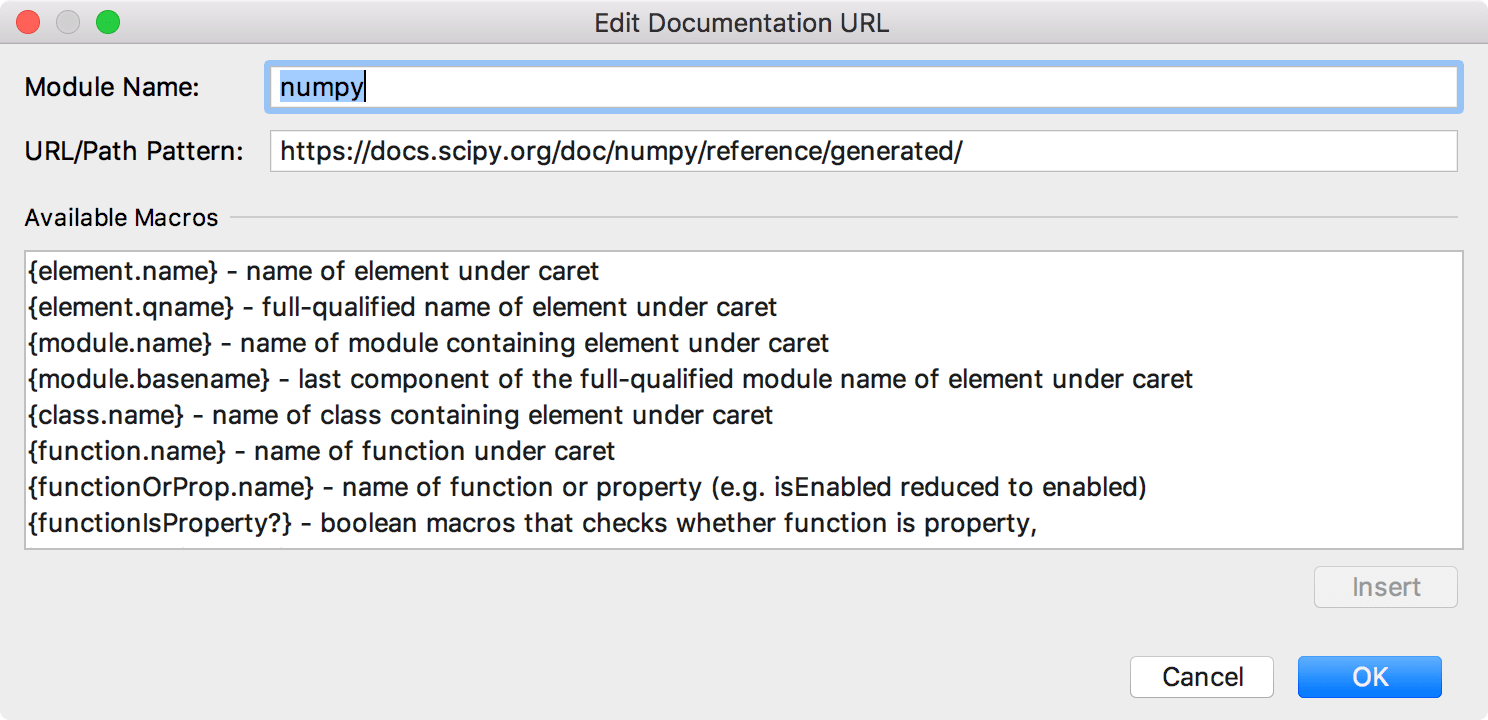
If external documentation resides locally, specify the local path to it.
To modify any of the preconfigured documentation URLs, select the documentation module in the Tools | External Documentation dialog and double-click it or click
.
To set up a URL pattern, select a macros in the Available Macros field and click the Insert button.

Note that each documentation module has its specific structure, so be careful when adding macros.
Type Info
In PyCharm, you can identify the type of an expression in the following way:
Place the caret at the necessary code element and press Ctrl+Shift+P (or select View | Type Info from the main menu).
Productivity tips
- Copy tooltip text to the clipboard
To copy tooltip text to the clipboard, hold Alt (on Linux, hold Ctrl+Alt) and click the tooltip.
- View context information
If the current method or class declaration is not visible, you can view it in the tooltip by pressing Alt+Q.